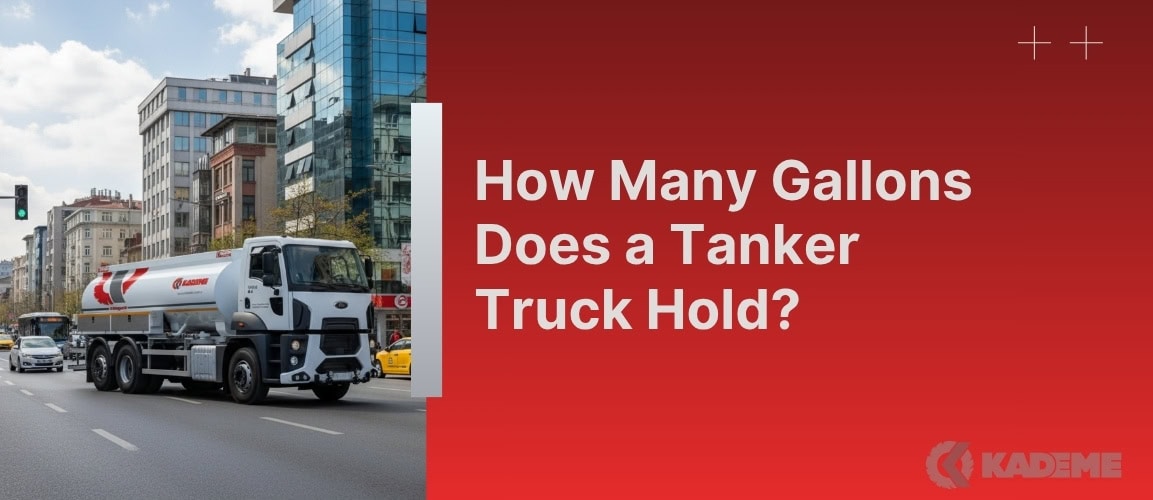The question “How many gallons does a tanker truck hold?” may appear simple, yet the answer depends on multiple technical and regulatory factors. A tanker’s actual capacity is not fixed. It is governed by legal weight limits, cargo density, tanker design, and regional regulations. Understanding these variables is essential to determine the real-world volume a tanker can legally and safely carry.
Key Takeaways
- A tanker truck’s capacity varies widely — from 1,000 to over 11,000 gallons depending on size and purpose.
- The 80,000-pound GVWR rule in the U.S. is the key factor limiting actual liquid volume, not just tank size.
- Liquid density directly affects how much a truck can legally carry; lighter liquids like gasoline allow greater volume than dense chemicals.
- Different tanker types — fuel, chemical, corrosive, gas, and cryogenic — each have unique structural and capacity limits.
- Operational laws, axle weights, and regional regulations (U.S. vs. EU) significantly shape design and usable capacity.
- The correct measure is not “how big the tank is” but how much it can legally and safely transport under given conditions.
Standard Capacity Classes
Small Tanker Trucks
These typically carry 1,000 to 3,000 gallons (3,785–11,355 liters). They are built for local delivery where agility matters — such as home heating oil, LPG, or aviation fuel supply. Mounted on light single-axle chassis, they navigate narrow streets and construction zones efficiently.
Medium Tanker Trucks
Medium units hold 3,000 to 7,500 gallons (11,355–28,390 liters). They balance volume with maneuverability and often serve regional fuel or milk distribution. Tandem or tri-axle layouts improve weight distribution while maintaining stability.
Large Tanker Trucks
Large highway tankers reach 5,500 to 11,600 gallons (20,820–43,910 liters). Some specialized models exceed 13,000 gallons depending on local laws. These are long-haul vehicles transporting petroleum, chemicals, or water over interstate routes and require careful route planning due to bridge and clearance limits.
Why Weight Determines Capacity
The 80,000-Pound Federal Rule
In the United States, the maximum legal gross vehicle weight (GVWR) for interstate transport is 80,000 pounds (≈36,287 kg). This includes the truck’s empty weight (tare), cargo, driver, and fuel. A heavy tractor or steel tank leaves less allowable cargo weight than a lighter aluminum model.
The Role of Cargo Density
Every liquid has a unique weight per gallon. A truck that can legally carry 7,800 gallons of gasoline (≈6.2 lbs/gal) might only haul 3,200 gallons of sulfuric acid (≈15 lbs/gal) before reaching the same legal weight. Thus, “capacity” changes with the liquid’s density — it is a calculation, not a constant number.
| Liquid Type | Weight (lbs/gal) | Max Legal Volume (for 48,000 lb net load) |
|---|---|---|
| Gasoline | ~6.2 | ~7,750 gal |
| Diesel | ~7.1 | ~6,760 gal |
| Water | ~8.34 | ~5,755 gal |
| Milk | ~8.6 | ~5,580 gal |
| Sulfuric Acid | ~15 | ~3,200 gal |
Axle and Bridge Formula Limits
Even if a vehicle is below 80,000 lb total, improper weight distribution can violate axle load or bridge spacing rules. Federal law restricts single axles to about 20,000 lb and tandem groups to 34,000 lb. Therefore, capacity also depends on how the load is spread across the chassis.
Tanker Types and Their Typical Capacities
Fuel Tankers (DOT 406 / MC 306)
Hold 9,000–11,600 gal of gasoline or diesel. Built from lightweight aluminum to maximize payload, often divided into multiple compartments for different fuel grades.
Chemical Tankers (DOT 407 / MC 307)
Carry 4,000–8,000 gal of corrosive or reactive chemicals. Made from stainless steel, insulated, and rated for moderate pressure. Heavier construction reduces usable volume.
Corrosive Liquid Tankers (DOT 412 / MC 312)
Contain 4,000–7,000 gal of acids. Reinforced, rubber-lined stainless tanks add significant tare weight.
Pressurized Gas Tankers (MC 331)
Transport LPG or ammonia. “Bobtail” trucks hold about 3,500 gal, while large trailers reach 11,500 gal. Thick carbon-steel shells withstand pressures up to 500 psig.
Cryogenic Tankers (MC 338)
Move liquefied gases such as nitrogen or oxygen. Capacity ranges 4,500–5,550 gal, but double-wall insulation and vacuum systems make them heavy.
Water Tankers
Used in agriculture, firefighting, and construction. Road-legal units carry 2,000–6,000 gal, while off-road mining trucks can exceed 60,000 gal when not subject to highway weight limits.
Regulatory and Regional Differences
U.S. Standards
The Federal Motor Carrier Safety Administration (FMCSA) enforces national weight and bridge laws. States may modify these rules for local roads; for instance, Alabama allows 84,000 lb on certain non-interstate routes.
Europe and Other Regions
European ADR standards favor smaller, narrower tanks optimized for older urban road networks. Design philosophy emphasizes maneuverability over maximum volume. The U.S., by contrast, prioritizes efficiency across long, straight highways.
Explore Kademe Water Tanker and Sprinkler Trucks
Kademe Water Tanker and Sprinkler Trucks provide a durable, efficient, and multifunctional solution for water transport and distribution. With 8,000 to 18,000-liter tank capacities and customizable ST-52 or stainless-steel construction, they are ideal for municipal and industrial operations.

Operational Considerations
Physical size — length, width, and height — affects access, turning, and route selection. A fully legal tanker might still be unusable on a tight delivery site. Operational protocols such as the 95 percent fill rule prevent overexpansion and liquid surge during transport. Internal baffles or bulkheads further stabilize the cargo.
Conclusion
There is no single answer to how many gallons a tanker truck can hold. Capacity depends on four primary pillars:
- Tanker Class – small, medium, or large configuration.
- Cargo Density – heavier liquids reduce permissible volume.
- Legal Weight Limits – GVWR, axle loads, and bridge formula constraints.
- Operational Context – route laws, design, and geography.
The correct question is not “What is a tanker’s capacity?” but “For this liquid, on this truck, under these conditions, what is the maximum legal and safe volume?”
This approach reflects the real intersection of physics, engineering, and transportation law that defines modern liquid logistics.





